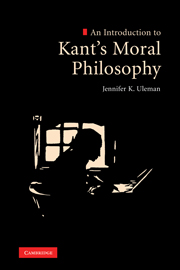Book contents
- Frontmatter
- Contents
- Acknowledgements
- 1 Introduction: the strange thing
- 2 A sketch of Kantian will: desire and the human subject
- 3 A sketch continued: the structure of practical reason
- 4 A sketch completed: freedom
- 5 Against nature: Kant's argumentative strategy
- 6 The categorical imperative: free will willing itself
- 7 What's so good about the good Kantian will? The appeals of the strange thing
- 8 Conclusion: Kant and the goodness of the good will
- Bibliography
- Index
2 - A sketch of Kantian will: desire and the human subject
Published online by Cambridge University Press: 05 June 2012
- Frontmatter
- Contents
- Acknowledgements
- 1 Introduction: the strange thing
- 2 A sketch of Kantian will: desire and the human subject
- 3 A sketch continued: the structure of practical reason
- 4 A sketch completed: freedom
- 5 Against nature: Kant's argumentative strategy
- 6 The categorical imperative: free will willing itself
- 7 What's so good about the good Kantian will? The appeals of the strange thing
- 8 Conclusion: Kant and the goodness of the good will
- Bibliography
- Index
Summary
Reason, in practice, has to do with a subject and especially with its faculty of desire.
KpV 5:20Like many people I know, I often try to draw abstract, non-spatio-temporal things on blackboards. When I start trying to draw the Kantian will, students become particularly hopeful. Having a clear picture of this unwieldy faculty would make life a lot easier – but after the first few circles and arrows, we all end up discouraged. There are too many different parts and pieces, interacting in too many different ways. These early chapters represent my efforts at offering, instead, a sketch in writing of the complicated Kantian will.
Kantian will is complicated because it is at once a faculty that desires, makes choices, and issues action-guiding rules. To say it desires is to say that it wants and wishes, that it has inclinations and interests. To say it makes choices is to say that it decides between possible ends or aims of action, picking which desires we act upon. To say it issues action-guiding rules is to say that it is a faculty that formulates maxims, as well as rules for deciding among possible maxims; it is to say that will authors, and represents to itself, and determines itself according to, principles.
To further complicate matters, Kantian will – encompassing desire, choice, and rule-making – is also at once thoroughly rational and thoroughly free, and also often incompletely rational and incompletely free.
- Type
- Chapter
- Information
- An Introduction to Kant's Moral Philosophy , pp. 23 - 38Publisher: Cambridge University PressPrint publication year: 2010



